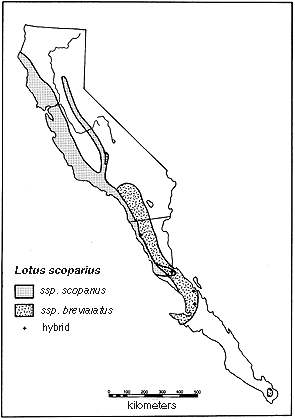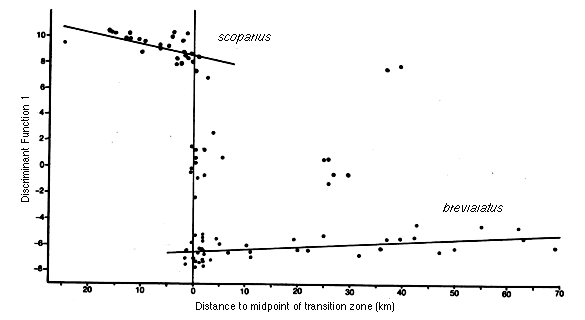Geographic distribution of flower morphological traits in subspecies of Lotus scoparius. Steppan, S.J. 1991. Journal of Biogeography. 18:321-331. |
Geographic distribution of flower morphological traits in subspecies of Lotus scoparius. Steppan, S.J. 1991. Journal of Biogeography. 18:321-331. |
Lotus scoparius (Nutt. in T. and G.) Ottley, a shrubby legume and early colonizer of disturbed sites, occurs in coastal and cismontane California and Baja California. The two principal subspecies are parapatrically distributed from Los Angeles, California, to El Rosario, Baja California. Within San Diego County, ssp. scoparius occurs within 15-30 km from the coast, while ssp. brevialatus (Ottley) Munz occurs further inland in the western edge of the Colorado Desert. The two subspecies meet in a complex transition zone, from 1 to 10 km wide, trending parallel to the coastline. Flower morphology is the only known characteristic distinguishing the two subspecies and their putative hybrid.
Discriminant analysis of the three morphs, using nine morphologic variables, provided a univariate measure along a scoparius-to-brevialatus continuum that explained 94% of the interpopulation variance. Discriminant function scores were regressed against spatial coordinates and Distance to the Midpoint of the Transition Zone. Both analyses showed a weak normal cline among ssp. scoparius populations with the axis of variation perpendicular to the transition zone. In contrast, among ssp. brevialatus the most scoparius-like populations were furthest from the transition zone. No cline was detected in the transition zone. Canonical correlation analysis showed that elevation, annual rainfall, and growing season evapotranspiration were moderately correlated with the distinguishing flower traits. However, among transition zone sites, no partitioning of the environment was evident. An evolutionary and biogeographic scenario is proposed by the author.

Figure 2. Geographic distribution of Lotus scoparius derived from 330 localities represented by 450 herbarium specimens.

Figure 5. DisFunc 1 scores versus distance to the Midpoint of the Transition Zone. The regression line defining the ssp. scoparius cline has an r-squared of 0.404 (P<0.001). though weak (r-squared="0.231)" the reverse cline in ssp. brevialatus is still significant (P<0.002).